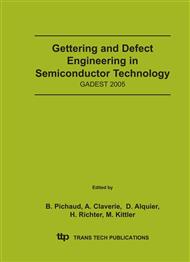p.477
p.483
p.489
p.497
p.503
p.509
p.515
p.519
p.525
Silicon Layers Grown on Siliconized Carbon Net: Producing and Properties
Abstract:
The paper describes the elaboration of a method for producing composite Si/SiC wafers and investigation of their properties. The known two-shaping elements (TSE) method was used to produce the material. Pilot tests show that this composite material can be used for production of solar cells. The structure of silicon grains is elongated relative to the growth direction, the dislocation density in grains is of about (5÷8) ×104 cm-2, the average lifetime of minority carriers is 4÷6 µs.
Info:
Periodical:
Pages:
503-508
Citation:
Online since:
December 2005
Keywords:
Price:
Сopyright:
© 2005 Trans Tech Publications Ltd. All Rights Reserved
Share:
Citation:


